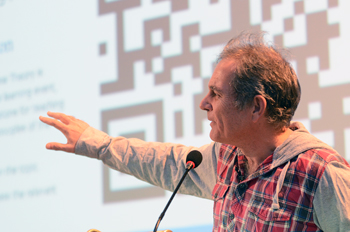Work clouds and rhizomatic learning – Prof Johannes Cronjé teaches through technology in inaugural lecture

Prof Johannes Cronjé |
Prof Johannes Cronjé has been appointed as visiting professor in the Faculty of Natural and Agricultural Sciences in collaboration with the Centre for Teaching and Learning. The driving force behind his appointment is to develop young and upcoming scholars in the field of online and blended learning at our university.The title of Prof Cronjé’s inaugural lecture, ‘Tablets, Painkillers or Snake Oil – a Remedy for Education?’ suggested a compelling event. Prof Cronjé did not disappoint.
“We live in a world where we carry more information in our pockets than in our entire head,” Prof Cronjé remarked. Interesting fact: an iPhone 4 has 16 million times more processing power than the Apollo 11 – the spacecraft that put the first man on the moon.
If students carry this much processing power in their hands, what should we be teaching students? Prof Cronjé asked. “I believe the answer to that is: we should be teaching them to teach themselves.”
Presenting his inaugural lecture in the same way as he would to his students, Prof Cronjé had the entire audience within minutes vigorously participating in the event.
Prof Cronjé advocates a process called rhizomatic learning. Knowledge, he explained, grows in a similar way to rhizomes’ roots – inseparably connected and seemingly without beginning or end. “Learning is a social aspect: people learn from one another.”
Making use of freely-available online applications, Prof Cronjé demonstrated the power of technology in the classroom. “My objective is to use technology to make people enthusiastic and motivated about the learning process.” Using their smartphones, tablets and laptops, the audience could effortlessly participate through connecting to each other by means of a virtual work cloud. “Knowledge is being created in the room as it happens,” Prof Cronjé explained, “motivating you to participate in this learning experience.”
“There are three things you need for group work to be successful: a mutual goal, individual responsibility and positive interdependence. Then it is real cooperative learning,” Prof Cronjé concluded.